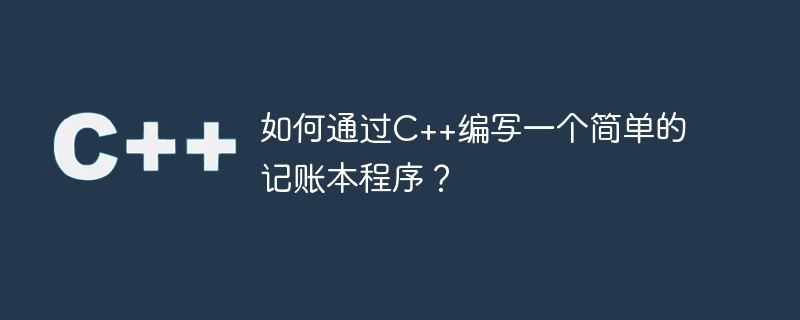如何通过C++编写一个简单的记账本程序?

本文将介绍如何使用C++编写一个简单的记账本程序,随着生活成本的不断上升,越来越多的人开始关注自己的财务状况。使用记账本可以记录收支情况,提高理财能力,C++语言的优势在于其高效性和可移植性,非常适合编写此类程序。
1.确定程序功能和需求
在编写程序之前,我们首先需要明确程序要实现的功能和需求,一个简单的记账本程序需要具备以下功能:
(1)能够记录每一笔支出和收入的金额和类型,并记录时间;
(2)能够计算总体收支情况,包括收入和支出的总数;
(3)能够生成报表,统计每个类型的支出和收入总和;
(4)能够对记录进行增删改查操作。
- 设计数据结构和算法
在程序中,我们需要使用数据结构来存储每一笔记录,常用的数据结构有线性表、栈和队列等。在此,我们选择使用线性表来存储每一笔记录,每条记录包括以下信息:
(1)记录的唯一ID编号;
(2)记录的时间戳;
(3)记录类型,包括收入和支出;
(4)记录金额;
(5)记录详情。
对于算法,我们需要设计函数来实现各种不同的操作,如添加、删除、更新、查询和统计,这些操作需要访问记录的数据,同时也需要计算收支总额和类型分类总和并生成相应的报表。
- 编写代码
在开始编写代码之前,我们需要进行一些准备工作,包括:
(1)选择一个集成开发环境(IDE),例如Visual Studio;
(2)学习C++基本语法和使用STL库进行编程;
(3)设计程序的类和函数。
在C++中,我们可以使用类来表示记账本程序,这个类可以包含各种成员函数和成员变量,以及相应的访问控制符。
下面是一个简单的记账本程序的代码示例:
#include <iostream>
#include <vector>
using namespace std;
class Record {
public:
int id;
string date;
string type;
double amount;
string description;
Record(int _id, string _date, string _type, double _amount, string _description) {
id = _id;
date = _date;
type = _type;
amount = _amount;
description = _description;
}
};
class AccountBook {
public:
vector<Record> records;
void addRecord(int id, string date, string type, double amount, string description) {
records.push_back(Record(id, date, type, amount, description));
}
void deleteRecord(int id) {
for (vector<Record>::iterator it = records.begin(); it != records.end(); it++) {
if (it->id == id) {
records.erase(it);
break;
}
}
}
void updateRecord(int id, double amount) {
for (vector<Record>::iterator it = records.begin(); it != records.end(); it++) {
if (it->id == id) {
it->amount = amount;
break;
}
}
}
void searchRecords(string type) {
for (vector<Record>::iterator it = records.begin(); it != records.end(); it++) {
if (it->type == type) {
cout << "ID: " << it->id << endl;
cout << "Date: " << it->date << endl;
cout << "Type: " << it->type << endl;
cout << "Amount: " << it->amount << endl;
cout << "Description: " << it->description << endl;
}
}
}
void generateReport() {
vector<double> income(5, 0);
vector<double> expense(5, 0);
for (vector<Record>::iterator it = records.begin(); it != records.end(); it++) {
if (it->type == "Income") {
income[0] += it->amount;
if (it->description == "Salary") income[1] += it->amount;
else if (it->description == "Bonus") income[2] += it->amount;
else if (it->description == "Investment") income[3] += it->amount;
else if (it->description == "Gift") income[4] += it->amount;
}
else if (it->type == "Expense") {
expense[0] += it->amount;
if (it->description == "Food") expense[1] += it->amount;
else if (it->description == "Clothing") expense[2] += it->amount;
else if (it->description == "Housing") expense[3] += it->amount;
else if (it->description == "Transportation") expense[4] += it->amount;
}
}
cout << "Total income: " << income[0] << endl;
cout << "Salary: " << income[1] << endl;
cout << "Bonus: " << income[2] << endl;
cout << "Investment: " << income[3] << endl;
cout << "Gift: " << income[4] << endl;
cout << "Total expense: " << expense[0] << endl;
cout << "Food: " << expense[1] << endl;
cout << "Clothing: " << expense[2] << endl;
cout << "Housing: " << expense[3] << endl;
cout << "Transportation: " << expense[4] << endl;
}
double calculateBalance() {
double income = 0, expense = 0;
for (vector<Record>::iterator it = records.begin(); it != records.end(); it++) {
if (it->type == "Income") {
income += it->amount;
}
else if (it->type == "Expense") {
expense += it->amount;
}
}
return income - expense;
}
};
void printMenu() {
cout << "1. Add record" << endl;
cout << "2. Delete record" << endl;
cout << "3. Update record" << endl;
cout << "4. Search records" << endl;
cout << "5. Generate report" << endl;
cout << "6. Calculate balance" << endl;
cout << "7. Quit" << endl;
}
int main() {
AccountBook accountBook;
int choice;
while (true) {
printMenu();
cout << "Enter your choice: ";
cin >> choice;
if (choice == 7) {
cout << "Goodbye!" << endl;
break;
}
switch (choice) {
case 1: {
int id;
string date, type, description;
double amount;
cout << "Enter ID: ";
cin >> id;
cout << "Enter date (YYYY-MM-DD): ";
cin >> date;
cout << "Enter type (Income/Expense): ";
cin >> type;
cout << "Enter amount: ";
cin >> amount;
cout << "Enter description: ";
cin >> description;
accountBook.addRecord(id, date, type, amount, description);
cout << "Record added." << endl;
break;
}
case 2: {
int id;
cout << "Enter ID: ";
cin >> id;
accountBook.deleteRecord(id);
cout << "Record deleted." << endl;
break;
}
case 3: {
int id;
double amount;
cout << "Enter ID: ";
cin >> id;
cout << "Enter amount: ";
cin >> amount;
accountBook.updateRecord(id, amount);
cout << "Record updated." << endl;
break;
}
case 4: {
string type;
cout << "Enter type (Income/Expense): ";
cin >> type;
accountBook.searchRecords(type);
break;
}
case 5: {
accountBook.generateReport();
break;
}
case 6: {
cout << "Balance: " << accountBook.calculateBalance() << endl;
break;
}
default: {
cout << "Invalid choice." << endl;
break;
}
}
}
return 0;
}- 测试程序
在完成代码编写后,我们需要对程序进行测试。测试程序的具体方法包括:
(1)输入数据和操作,例如添加、删除、更新、查询、报表等;
(2)检查程序是否输出了正确的结果;
(3)检查程序是否能够正常退出。
在测试期间,我们可以使用不同的数据进行测试,以确保程序的正确性和稳定性。如果发现程序存在问题,需要对代码进行修改和调试。
- 总结
本文介绍了如何使用C++编写一个简单的记账本程序,包括确定程序功能和需求、设计数据结构和算法、编写代码和测试程序。这个程序具有添加、删除、更新、查询、报表和计算余额等功能,能够帮助人们更好地管理自己的财务状况。通过学习本文内容,读者可以更深入地理解C++语言的应用和程序设计的基本方法,提高自己的编程水平。
以上是如何通过C++编写一个简单的记账本程序?的详细内容。更多信息请关注PHP中文网其他相关文章!

热AI工具

Undresser.AI Undress
人工智能驱动的应用程序,用于创建逼真的裸体照片

AI Clothes Remover
用于从照片中去除衣服的在线人工智能工具。

Undress AI Tool
免费脱衣服图片

Clothoff.io
AI脱衣机

AI Hentai Generator
免费生成ai无尽的。

热门文章

热工具

记事本++7.3.1
好用且免费的代码编辑器

SublimeText3汉化版
中文版,非常好用

禅工作室 13.0.1
功能强大的PHP集成开发环境

Dreamweaver CS6
视觉化网页开发工具

SublimeText3 Mac版
神级代码编辑软件(SublimeText3)

热门话题
 char在C语言字符串中的作用是什么
Apr 03, 2025 pm 03:15 PM
char在C语言字符串中的作用是什么
Apr 03, 2025 pm 03:15 PM
在 C 语言中,char 类型在字符串中用于:1. 存储单个字符;2. 使用数组表示字符串并以 null 终止符结束;3. 通过字符串操作函数进行操作;4. 从键盘读取或输出字符串。
 在Docker环境中使用PECL安装扩展时为什么会报错?如何解决?
Apr 01, 2025 pm 03:06 PM
在Docker环境中使用PECL安装扩展时为什么会报错?如何解决?
Apr 01, 2025 pm 03:06 PM
在Docker环境中使用PECL安装扩展时报错的原因及解决方法在使用Docker环境时,我们常常会遇到一些令人头疼的问�...
 c上标3下标5怎么算 c上标3下标5算法教程
Apr 03, 2025 pm 10:33 PM
c上标3下标5怎么算 c上标3下标5算法教程
Apr 03, 2025 pm 10:33 PM
C35 的计算本质上是组合数学,代表从 5 个元素中选择 3 个的组合数,其计算公式为 C53 = 5! / (3! * 2!),可通过循环避免直接计算阶乘以提高效率和避免溢出。另外,理解组合的本质和掌握高效的计算方法对于解决概率统计、密码学、算法设计等领域的许多问题至关重要。
 c语言多线程的四种实现方式
Apr 03, 2025 pm 03:00 PM
c语言多线程的四种实现方式
Apr 03, 2025 pm 03:00 PM
语言多线程可以大大提升程序效率,C 语言中多线程的实现方式主要有四种:创建独立进程:创建多个独立运行的进程,每个进程拥有自己的内存空间。伪多线程:在一个进程中创建多个执行流,这些执行流共享同一内存空间,并交替执行。多线程库:使用pthreads等多线程库创建和管理线程,提供了丰富的线程操作函数。协程:一种轻量级的多线程实现,将任务划分成小的子任务,轮流执行。
 distinct函数用法 distance函数c 用法教程
Apr 03, 2025 pm 10:27 PM
distinct函数用法 distance函数c 用法教程
Apr 03, 2025 pm 10:27 PM
std::unique 去除容器中的相邻重复元素,并将它们移到末尾,返回指向第一个重复元素的迭代器。std::distance 计算两个迭代器之间的距离,即它们指向的元素个数。这两个函数对于优化代码和提升效率很有用,但也需要注意一些陷阱,例如:std::unique 只处理相邻的重复元素。std::distance 在处理非随机访问迭代器时效率较低。通过掌握这些特性和最佳实践,你可以充分发挥这两个函数的威力。
 蛇形命名法在C语言中如何应用?
Apr 03, 2025 pm 01:03 PM
蛇形命名法在C语言中如何应用?
Apr 03, 2025 pm 01:03 PM
C语言中蛇形命名法是一种编码风格约定,使用下划线连接多个单词构成变量名或函数名,以增强可读性。尽管它不会影响编译和运行,但冗长的命名、IDE支持问题和历史包袱需要考虑。
 C 中releasesemaphore的用法
Apr 04, 2025 am 07:54 AM
C 中releasesemaphore的用法
Apr 04, 2025 am 07:54 AM
C 中 release_semaphore 函数用于释放已获得的信号量,以便其他线程或进程访问共享资源。它将信号量计数增加 1,允许阻塞的线程继续执行。
 Dev-C 版的问题
Apr 03, 2025 pm 07:33 PM
Dev-C 版的问题
Apr 03, 2025 pm 07:33 PM
Dev-C 4.9.9.2编译错误及解决方案在Windows11系统使用Dev-C 4.9.9.2编译程序时,编译器记录窗格可能会显示以下错误信息:gcc.exe:internalerror:aborted(programcollect2)pleasesubmitafullbugreport.seeforinstructions.尽管最终显示“编译成功”,但实际程序无法运行,并弹出“原始码档案无法编译”错误提示。这通常是因为链接器collect






